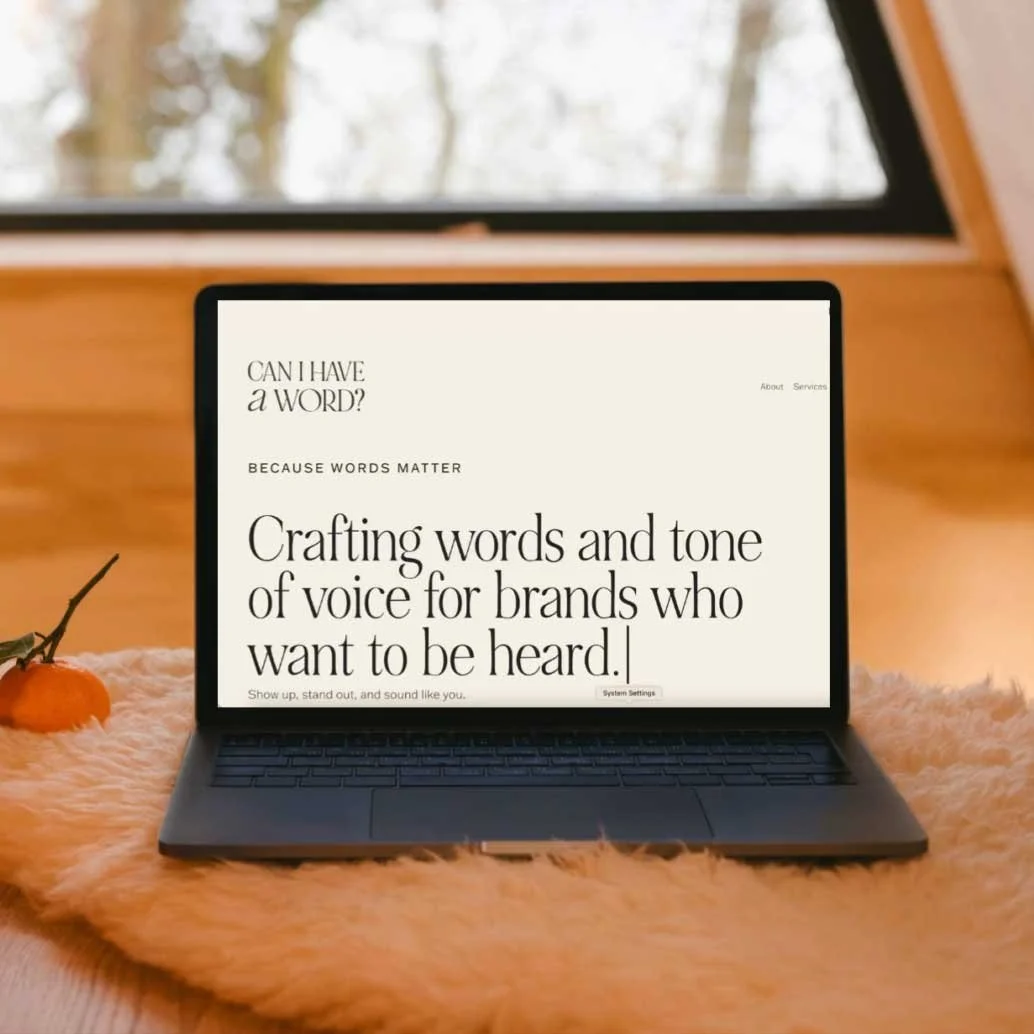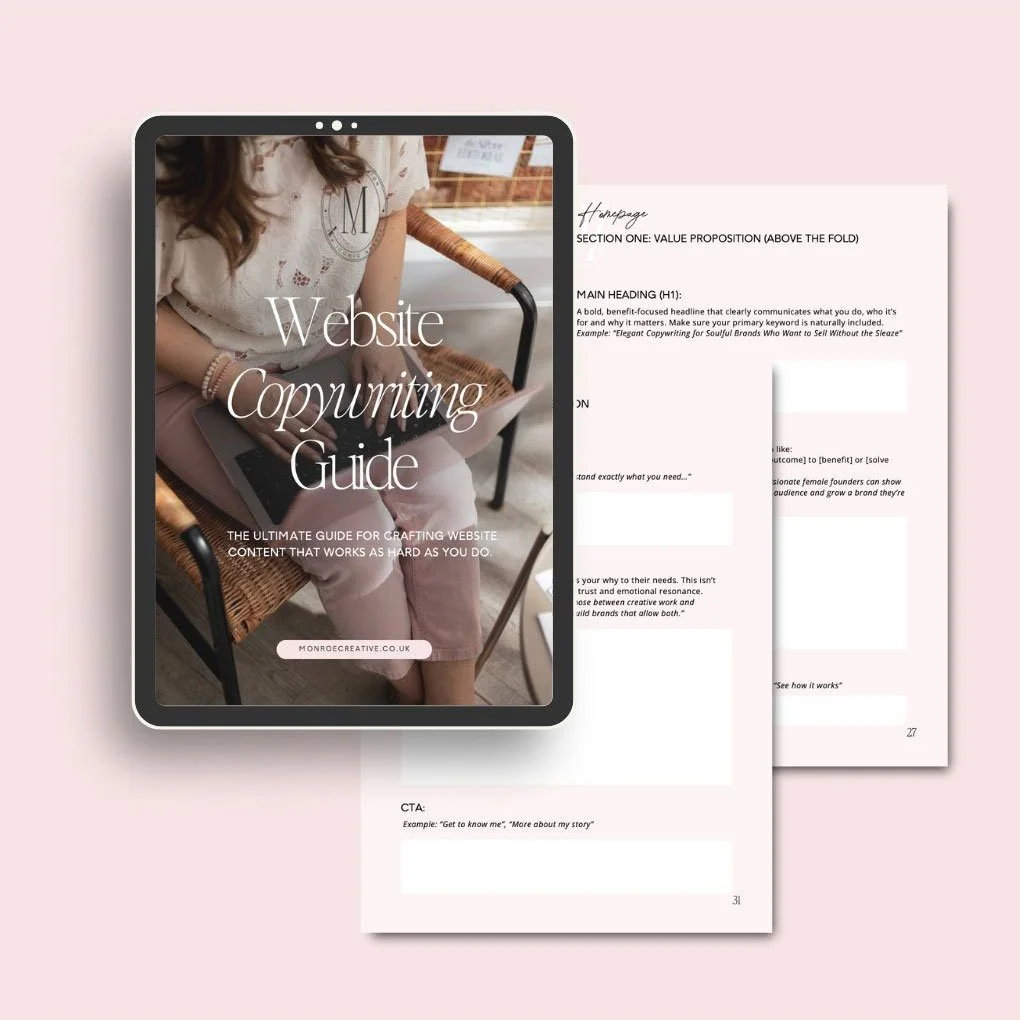How to Write Website Copy That Connects and Converts (Even if You’re Not a Copywriter)
Having designed a fair few websites in my time (including an absolute shocker of a website for my very own first brand!) I totally get how overwhelming it can feel to sit down to write your website copy.
Now, as an experienced brand and website designer, time and time again I see my lovely clients freeze at the copy stage:
“What do I actually write here?”
“How do I make it sound like me?”
“How do I write something that gets me found online... and doesn’t take me forever?”
To be clear, I truly believe that the magic of a great copywriter could never be replaced and by the way, I can recommend some amazing word nerds if you want one!) but if the budget doesn’t allow it or you want to do it yourself, I’m hoping this post will be a helpful starting point to get you started. (If you're looking for structure, prompts and strategy to take this even further, I created a full guide to help - more on that at the end!)
1. Start with strategy (because copy without direction will always fall flat)
Strategy-first is always my go-to method - for designing branding, websites and actually, a lot of my day-to-day life! And this absolutely should apply to writing your website copy. Before even picking up your pen (or turning on your computer), you must be clear on your brand strategy and have a really solid idea of who your ideal customer is.
Working on your brand strategy means that you will be able to clearly understand your positioning, messaging, voice and tone and this needs to be consistent throughout your website copy. Likewise, a deep understanding of your ideal client is crucial - you are writing your website for them, after all! Keep them front of mind, always.
Mini tip - consider these prompts:
“Who are you writing for?” (Include their dreams, pain points, struggles etc)
“What's the transformation they’re looking for?”
“How do you want your brand to feel to them?”
2. Write for humans first, Google second
Helpful, people-first content
In its guidance, Google tells us that they will prioritise and rank content that is helpful, reliable and ‘people-first’. This is where the deep understanding of your target audience will come into play, because when you know and understand them deeply, you can figure out what kind of content is helpful for them and you can write directly to them.
Benefits over features
Focussing on benefits over features is crucial because your clients don’t just want to know what you offer, they want to know why it matters to them and how it will make their life better - it’s about what they gain, not just what you do. What does this look like in practice?
A feature of a wedding planner’s service might be “a full day coordination and supplier liaison” but how they actually benefit from this is “you can actually enjoy your wedding day, knowing every last detail is taken care of.”
A feature of a wellbeing coach’s offering might be a “6-week 1:1 coaching programme”. The benefits for the client are “feel calmer, clearer and more in control of your everyday life - without burning yourself out.”
A feature of a brand photographer’s package might be a “2-hour personal branding shoot with outfit changes” but the actual benefit to the client looks like: “you finally have a gallery of images that feel just like you - and actually make you want to show up online.”
Use your customers’ language
One super easy tip to consider is to pull words and phrases that your real-life customers or clients have used, and put it into your copy - on your website, social media captions and marketing. Look through testimonials, emails and sales calls and you can literally use your target customer’s words right back at them!
Mini tip:
Before you write a word, open your testimonials folder - that’s where your messaging gold lives.
3. Every page needs a purpose (and a keyword!)
To ensure your website is clear, structured and offers a great user experience, each page should have a clear goal, a primary keyword that you want to target, supporting keywords and a clear CTA (call to action). This not only keeps you on track when writing your content, but also ensures that it’s easy for the visitor to consume and is optimised to rank well in search engines.
As an example, the Homepage for a Luxury Wedding Planner might have the following:
Goal: Confirm they’re in the right place and guide them through the site
Keyword: e.g. “wedding planner London”
CTA: Lead to services, about, contact
For the same business, their structure for the About page might look like:
Goal: Build trust and relatability
Keyword: e.g. “about [business name]”
CTA: Encourage deeper connection (lead to services, discovery call or email list)
Mini tip:
See my blog post about what to include on your homepage for a deep dive of this very important piece of your website puzzle!
4. A few final tips that make a big difference
Structure your pages for scannability - website visitors are busy and often rushed - it’s likely that the only person who has actually read your entire website is your Mum! So, utilise headings and subheadings to break up your content into manageable sections, then use short paragraphs, bullet points and lots of white space.
Make sure every page has a Call to Action, and that it focuses on what’s in it for them not just what they ‘get’.
Aim for 500+ words on most pages (except for pages where that’s not viable such as your Contact page). Google likes depth and more words gives it more to go on, which means it can understand your content much better and show it to the right people.
Don’t forget all the boring backend bits - metadata, image alt text and internal links where possible. Yes, it’s a bit dull but every little counts when it comes to SEO and getting your website in front of the right people!
Want a little more help?
If you're DIYing your copy and want a clear framework to help you actually get it done, my Website Copywriting Guide might be perfect for you
I created it using my years of experience designing beautiful and powerful websites and it's the exact structure I've used with dozens of clients. It’s perfect for founders who want (strategy-backed) guidance and not generic, robotic copy (hi, Chat GPT!)
It includes lots of prompts to help you figure out your brand voice, the important SEO foundations you’ll need along with super simple to follow copy templates to make writing your website copy much less stressful! It's editable, easy to use and can evolve with your brand
It’s the next best thing to hiring a copywriter (and created by someone who’s seen what actually works).







